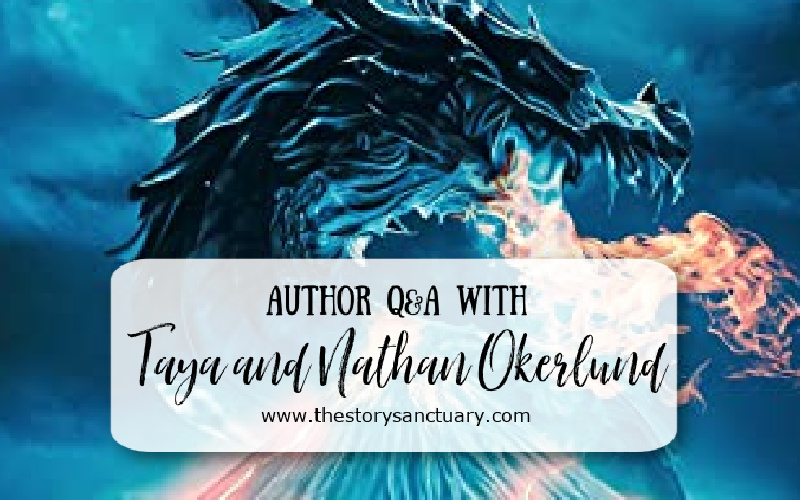
Author Q&A with Bookerlunds Taya and Nathan Okerlund
I knew from the moment that I first read about this book that I would request to review it. The book description and email from the author were so cleverly worded and in such a great voice! I couldn’t resist. So, I was even more thrilled when the authors offered to let me host them for a Q&A post.
If you haven’t checked out my review of NEVER LORE, please pop over there either before or after reading this post because if you like fantasy adventure middle grade books, you do NOT want to miss this one.
Let’s get to the Q&A with the Bookerlunds!
1. I find that a story was often inspired by a question. Was there a question that inspired you?
Never Lore is a spy story and spy stories are full of deceit. Early on in my career, after receiving my security clearance, I learned about people who could avoid detection in their lies by being strictly factual, without a hint of honesty. Honesty is a nuanced thing and the way adults typically model it for children, it can be kind of hard to crack. I raised a number of questions for kids to think about in this story. I hope I used enough restraint in not answering all of them for the reader. It’s a fact, I come down on the side of truth, but a story won’t really resonate when it lies to you. And I wouldn’t do that.
2. Who is your favorite character? Are there things about your favorite character which couldn’t be included in NEVER LORE?
Annabelle was partly inspired by my fearless niece. In fact, her name is Annabelle. She’s pretty grown up now, but wow was she a firecracker when she was nine! So many stories about that kid! So many broken bones! Is she up to eight or nine? I’m not sure I captured her with quite the same spirit, but I gave it a go!
3. What was the most difficult thing about writing NEVER LORE?
This book was at least six years in the making. While it is crucial to follow the rules of story craft and to accept feedback, an author can lose her way by caring too much about what someone else thinks of her book. This one took me time to find the all-important-element that no story expert can give a writer—Voice.
4. Is there a scene or moment in your novel that really sticks with you? Can you tell us a little bit about it?
I still love the night hyena scene. My daughter was only four when I began writing Never. At the time, we watched quite a few nature documentaries together, and there was this episode where an injured mother hyena was turned out of her pack with her babies. The little exiles didn’t make it, and it gutted my little girl to see this, so she asked me to put hyenas in the story. I wrote up the scene, and thought it was pretty good, until my husband got hold of it and proceeded to set it on fire! It’s still my favorite scene, mostly because it’s the product of our whole family collaborating together.
5. What was the most challenging thing you had to overcome as a writing team in order to finish NEVER LORE?
I don’t like to talk about this, because it’s still tender to me, but I went through years of painful disability and a slow and painful healing process before I was able to both finish and see Never through to publication.
6. What do you most hope readers take away from your novel?
I hope readers have a great adventure! As a bonus, I hope they will sometimes think about hard questions like: what is a lie? What is the truth? And in either case—what happens next?
7. What is one question about your novel you are often asked by readers?
As I mentioned, Never was a bit of a family project, and so people might wonder what or who BOOKERLUNDS is. Our family name is Okerlund. So we added a couple of letters and thought we were being clever. In any case, we are definitely bookish people.
About Bookerlunds Taya and Nathan Okerlund
Facebook | Instagram | Website
The Bookerlunds are an author team composed of Taya and Nathan Okerlund and their daughter Mimi. (Mimi made meaningful contributions to this book by insisting that hyenas make it into the manuscript.) And we’re glad she did.
Nathan is a neuroscientist who works in a laboratory at the University of Utah, studying model organisms such as nematodes to try to unlock the mysteries of neuro degeneration, or declines in the functioning of the brain. He has published a lot of papers before in peer reviewed journals, but this is his first work of fiction.
Taya is a multi award-winning author of SHIN and other novels. NEVER LORE is her first middle-grade novel.
About Never Lore: Journey to Mt. Smolder
Amazon | Bookshop | Goodreads | My Review
NOTICE: Explosive content contained within. (Rebel boys and indomitable girls have always been a combustible combination.)
All the signs of Fairy’s unraveling were there: a strict rationing of pixie dust; the disappearance of a magical species; a reckless reliance on spies plucked from human orphanages. Annabelle was no orphan. Her father was perhaps the most infamous man in Childerbridge-and she’d never live down the shame of it, though she’d also never accept that the charges against him were true-not most of the time.
She’ll have to go to the end of Never to prove what is true…about Never itself, about her father, and her own work-worn self.